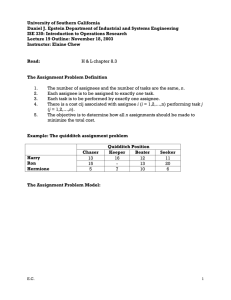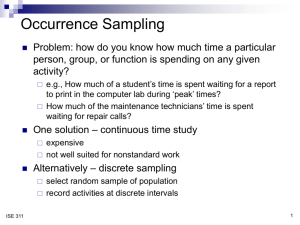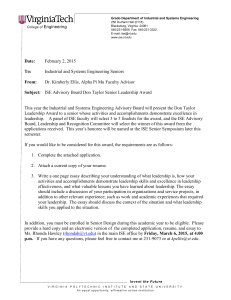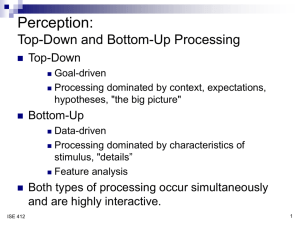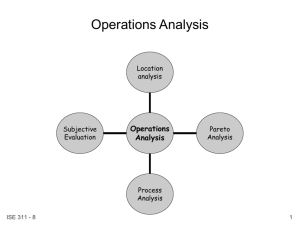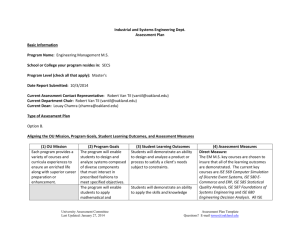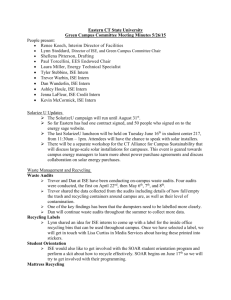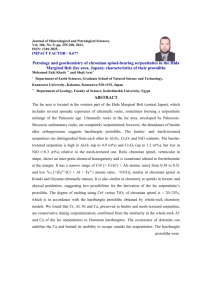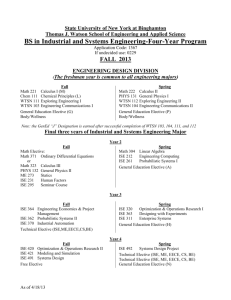ISE 330: Introduction to Operations Research
advertisement
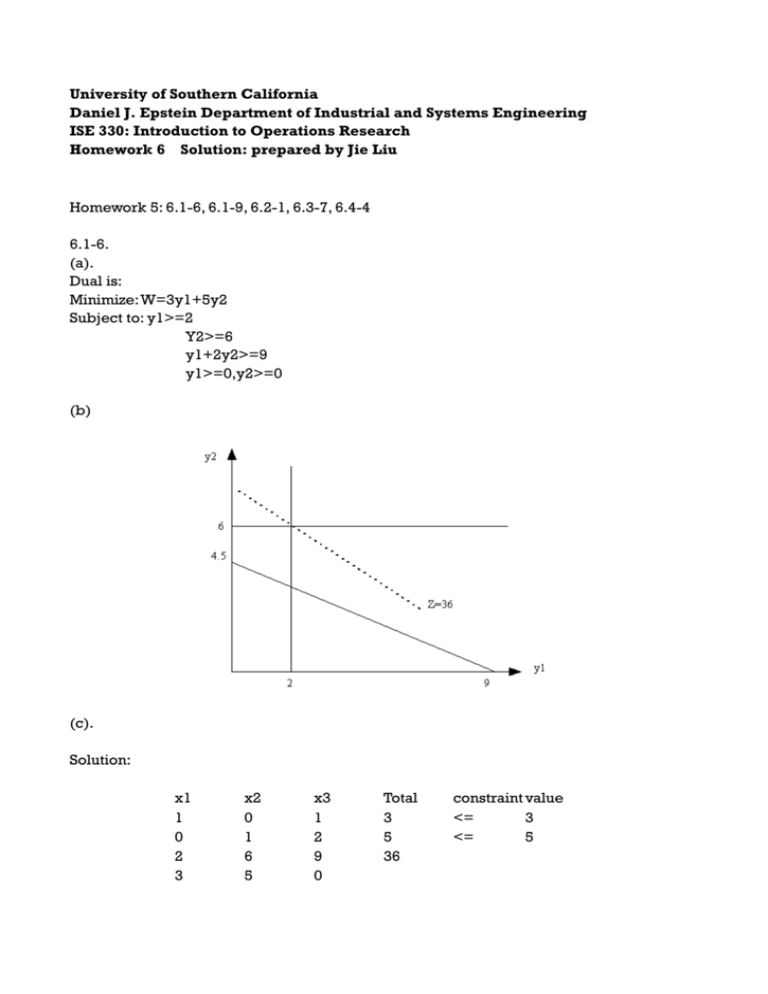
University of Southern California Daniel J. Epstein Department of Industrial and Systems Engineering ISE 330: Introduction to Operations Research Homework 6 Solution: prepared by Jie Liu Homework 5: 6.1-6, 6.1-9, 6.2-1, 6.3-7, 6.4-4 6.1-6. (a). Dual is: Minimize: W=3y1+5y2 Subject to: y1>=2 Y2>=6 y1+2y2>=9 y1>=0,y2>=0 (b) (c). Solution: x1 1 0 2 3 x2 0 1 6 5 x3 1 2 9 0 Total 3 5 36 constraint value <= 3 <= 5 ISE 330: Homework 6 Solutions http://www-classes.usc.edu/engr/ise/330 Final Reduced Objective Allowable Allowable Cell $B$5 $C$5 $D$5 Name Value x1 x2 x3 3 5 0 Cost 0 0 -5 Coefficient Increase Decrease 2 6 9 1E+30 1E+30 5 2 2.5 1E+30 Final Shadow Constraint Allowable Allowable Cell $E$2 $E$3 Name Value Price Total Total 3 5 2 6 R.H. Side Increase Decrease 3 5 1E+30 1E+30 3 5 6.1-9. Primal: Max: Z=x1+x2 Subject to: -x1+x2<=1 x1-x2<=0 x1>=0, x2>=0 (Let x1=x2=c and c to infinity, Z=2c is unbounded) Dual: min W=y1 Subject to: -y1 + y2>=1 y1 – y2>=1 y1>=0, y2>=0 (No feasible points) 2 ISE 330: Homework 6 Solutions http://www-classes.usc.edu/engr/ise/330 6.2-1. (a). Iter0: Since all coefficients are zero, at the current solution (0,0), the 3 resources (production time per week at plant 1, 2 and 3) are “free goods”. That is, having more doesn’t increase our objective. Iter1: [0, 3/2, 0]. Now, resource 2 has been entirely used up and contributes 3/2 to profit per unit of resource. Since this is positive, it is worth while to continue fully using this resource. Iter2: [0,3/2,1]. Resource 2 and 3 are used up and contributes a positive amount to profit. Resource 1 is a free good while resources 2 and 3 contribute 3/2 and 1 per unit of resource, respectively. (b). Iter0: [-3,-5] Both activities 1 and 2(# batches of product 1 and 2 producted per week can be initiated to give a more profitable allocation of the resources. That is, the current contribution to profits of the resources required to produce 1 batch of product 1 or 2 is smaller than the unit profit per batch of product 1 or 2, respectively. Iter1: [-3,0] Again activity 1 can be initiated to give a more profitable use of resources, but activity 2 is already being produced (or the resources are being used just well in other activities). Iter2 [0,0] Both activities are being produced (or the resources are being used just as profitable elsewhere). 3 ISE 330: Homework 6 Solutions http://www-classes.usc.edu/engr/ise/330 (c). Iter1: Since activities 1 and 2 can be initiated to increase profit (give a same amount of resources), we choose to increase one of these. We choose activity 2 as the entering activity (basic variable), since it increases the profit by 5 for every unit of product 2 produced (as opposed to 3 product 1). Iter2: Only activity 1 can be initiated for more profit, so we do so. Iter3: Both activity 1 and 2 are being used. Furthermore, since the coefficients for x3, x4 and x5 are non-negative, it is not worthwhile to cut back on the use of any of the resources. Thus, we must be at the optimal solution. 6.3-7 (a). minimize: subject to: w=6y1+15y2 y1+4y2>=2 3y1+6y2>=5 2y1+5y2>=3 3y1+7y2>=4 y1+y2>=1 y1>=0, y2>=0 (b). 4 ISE 330: Homework 6 Solutions http://www-classes.usc.edu/engr/ise/330 (c). (z1-c1) and (z2-c2) are nonbasic in the dual, so x1 and x2 are basic in the optimal primal solution. (d) Bas Var z X6 X7 Eq No. 0 1 2 Coefficient of z X1 1 -2 0 1 0 4 Bas Var z X2 X7 Eq No. 0 1 2 Coefficient of z X1 1 -1/3 0 1/3 0 2 Bas Var z X2 X1 Eq No. 0 1 2 Coefficient of z X1 1 0 0 0 0 1 RHS X2 -5 3 6 X3 -3 2 5 X4 -4 3 7 X5 -1 1 1 X6 0 1 0 X7 0 0 1 0 6 15 RHS X2 0 1 0 X3 1/3 2/3 1 X4 1 1 1 X5 2/3 1/3 -1 X6 5/3 1/3 -2 X7 0 0 1 10 2 3 RHS X2 0 1 0 X3 1/2 1/2 1/2 X4 7/6 5/6 1/2 X5 1/2 1/2 -1/2 X6 4/3 2/3 -1 X7 1/6 -1/6 1/2 10.5 1.5 1.5 (e). The defining equations are: x1+3x2+2x3+3x4+x5=6 4x1+6x2+5x3+7x4+x5=15 x3 =0 x4 =0 x5 =0 which have solution (x1,x2,x3,x4,x5)=(3/2,3/2,0,0,0) 6.4-4 (a). Dual is: Maximize: V=y1+y2 Subject to: -2y1+y2<=1 y1-2y2<=2 5 ISE 330: Homework 6 Solutions http://www-classes.usc.edu/engr/ise/330 y1>=0, y2>=0 6 ISE 330: Homework 6 Solutions http://www-classes.usc.edu/engr/ise/330 (b). since V can be increased indefinitely, the primal problem cannot have any feasible solutions. (This can be shown by weak duality, keeping in mind that the primal and dual are “reversed” in this problem). 7
